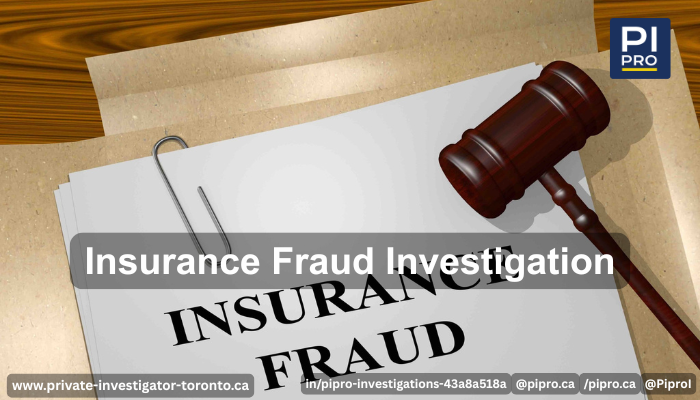
Insurance Fraud Investigation
The annual amount of money that insurance fraud takes from both companies and policyholders continues to rise considerably. The practice of making false claims yields two significant detrimental effects which include monetary losses and elevated premiums for insurance policyholders who act honestly. Insurance fraud investigation acts as a solution to detect fraudulent situations. Insurance fraud investigation functions as a targeted procedure which aids insurance companies in locating phony claims together with stopping deceptive insurance behaviours. This article explains the nature of insurance fraud investigation besides examining fake claims detection techniques together with showing how fraud prevention protects the industry.
What Is Insurance Fraud Investigation?
Insurance firms together with private investigators perform a detailed investigational method for uncovering fraudulent insurance claims. The process consists of two parts: first investigators gather proof through observation and then they apply cutting-edge forensic methods alongside keeping watch over suspects to verify claim authenticity. The analysis associates with law enforcement authorities and attorneys to ensure proper prosecution of fraudsters.
Common Types of Insurance Fraud
-
False Claims:
An individual who invents non existent claims or makes them for non existent incidents is perpetrating false reporting to insurers. Fraudsters achieve false claims through the production of counterfeit police reports in addition to creating fabricated documents and manipulating evidence into belief-worthy pieces.
-
Exaggerated Claims:
The claimant files a legitimate report of an incident yet chooses to expand the actual extent of their damages for higher payment benefits. Insurance fraud claims in personal injury together with property damage incidents occur frequently.
-
Staged Accidents:
Certain individuals participate in staged collisions with the purpose of preparing false insurance compensation requests. Staged accidents by fraudsters normally happen with the help of more parties such as staged witnesses and compromised medical staff.
-
Falsified Medical Claims:
Medical fraud occurs when fraudulent medical service professionals submit fake billing claims for non existing medical procedures. The practice is widespread throughout health insurance fraud investigations.
-
Property Fraud:
Insurance claimants swindle payments by reporting stolen or lost belongings which do not belong to them and by conducting bogus damage reports that allow them to obtain insurance benefits.
Fake Claims Detection
The detection of fraudulent insurance claims represents the fundamental element for insurance fraud investigative processes. The process of discovering fraudulent actions relies on different methods which investigators use in their investigations.
-
Surveillance Techniques
Private investigators at their firms execute both physical surveillance alongside electronic surveillance to test claim validity during insurance claim investigations. When an insured person engaged in physical exercises following injury admission they create suspicions about the validity of their insurance claim. Analysing evidence requires video-based documentation and photographic records coupled with digital activities monitoring.
-
Background Checks
Taking charge of full background procedures requires investigators to study all previous claims made by insured parties as well as their economic records and social media activity. A history of making previous claims indicates the person might have developed a pattern of fraudulent conduct. Factual investigators confirm employment records then examine relationships for indications of fraudulent activity.
-
Data Analytics and AI
Insurance companies merge AI technology with data analytics tools for their search of fraudulent insurance claims. The analysis of data by AI systems provides unexpected trend detection which leads to insurance fraud alerts for the insurer. The detection of fraudulent activity depends strongly on machine learning systems that detect errors contained in claim presentation techniques.
-
Interviewing Witnesses
The statements from witnesses along with medical experts and law enforcement officers enable investigators to verify claim authenticity. Acts of insurance fraud become evident when collected testimonies fail to match up. False assertions become evident through matching various evidence sources combined with detailed examination.
Fraud Prevention
Fraud avoidance stands equally important in relation to detecting fraud since both help minimize risk exposure. Insurance companies along with their investigators employ different prevention methods to reduce risks.
-
Educating Policyholders
The majority of fraudulent insurance claims become possible because people lack knowledge about the legal repercussions. Phased education about fraud laws along with the specified penalties aimed at policyholders helps decrease fraudulent conduct. The creation of awareness happens through informational brochures and workshops together with online resources.
-
Strengthening Claims Review Processes
Insurance organizations optimize their claims review systems through multiple verification procedures together with stringent documentation requirements during claim evaluation. Legitimate claims are the only ones which receive payments through this system. The risk of fraudulent claims getting approved decreases when organizations enforce complete assessment procedures.
-
Collaborating with Law Enforcement
Through their collaboration with law enforcement agencies insurers obtain the ability to respond rapidly against fraudulent activities by pursuing legal consequences and denying claims. Local authorities and specialized fraud investigation units permit companies to create advanced fraud prevention networks through their cooperation.
-
Implementing Fraud Detection Software
Advanced software tools identify suspicious insurance claims because these tools help reduce the risk for fraudulent payments to be made. The tools process multiple data sources to find irregularities by producing alerts about detected fraudulent activities. Such systems help businesses track down potential fraud when integrated within their claims processing systems to reduce inefficiencies.
Conclusion
Insurance fraud investigation protects insurance companies and real policyholders from financial loss with its essential protective role. The work of investigators ensures that insurance payments go only to members of the valid policyholder community. Insurance companies need to advance their investigative techniques and established prevention methods to match the changing methods used by fraudsters.
Artificial intelligence technology connects with data analytics to combine active police work when fighting fraudulent insurance claims for maximum results. People who have insurance need to actively fight fraud by providing accurate information about their policy coverage and immediately notifying suspicious occurrences. Financial losses caused by insurance-related fraud decrease when an industry implements transparency standards that combine with accountability measures.




